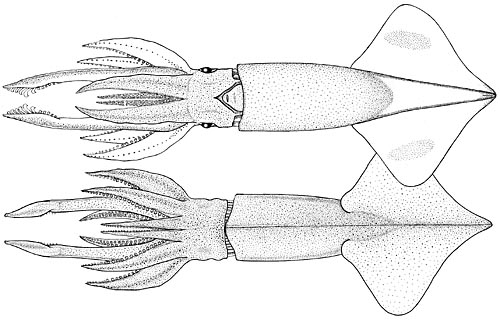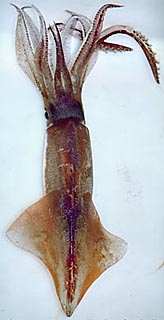Onychoteuthis compacta
Michael Vecchione, Richard E. Young, and Kotaro TsuchiyaIntroduction
O. compacta appears to be the most common of the three species of Onychoteuthis found in Hawaiian waters. It is most easily identified by characteristics of its pigment pattern. Juveniles and subadults have a distinctive region on the posteroventral surface of the mantle that lacks chromatophores.
Characteristics
- Tentacular club
- Club without marginal suckers in subadults.
- Distal 4 or 5? fully-formed hooks in ventral series with spikes (see arrow) that protrude through the skin.
 image info
image info  image info
image infoFigure. Oral views of tentacular club of O. compacta. Top - Original drawing by Keiko Hiratsuka Moore, National Marine Fisheries Service. Distal portion of club showing hook spikes (arrow), preserved. Photograph by R. Young.
Scanning electron micrographs of the hooks can be seen here.
- Mantle pigmentation
- Triangular-shaped region on the postero-ventral mantle lacks chromatophores.
 image info
image infoFigure. Ventrolateral view of the mantle of O. compacta, preserved, showing pigmentation, Hawaiian waters. Photograph by R. Young.
- Triangular-shaped region on the postero-ventral mantle lacks chromatophores.
Comments
Additional features of the description can be found here.Life History
Paralarvae of O. compacta are easily identified by the arrangement of their chromatophores. At 3-4 mm GL: A simple band (i.e., a single, straight line) of chromatophores is present along the free ventral margin of the mantle; a group of chromatophores is situated well posteriorly on the ventral mantle and two large chromatophores are located ventrally opposite the fins. At 6 mm GL: Two pairs of chromatophores are present on the ventral mantle adjacent to the fins. A small patch of chromatophores is present dorsally at the posterior convergence of the fins. At 9 mm GL: Two parallel rows of small chromatophores are located dorsally stradling the midline of the mantle. At 12-16 mm ML: Chromatophore numbers increase dramatically. At 18 mm ML: The subadult chromatophore pattern can be recognized.
 image info
image infoFigure. Ventral and dorsal views of paralarval and juvenile O. compacta. A - 2.3 mm GL. B - Ventral view of a common condition in this species: head retracted within the mantle cavity, 4.8 mm GL. C - 4.1 mm GL. D - 8.9 mm GL. E - 18.5 mm GL. The bar is 1 mm. Drawings from Young and Harman (1985).
References
Berry, S. S. 1913. Some new Hawaiian cephalopods. Proc. U. S. Nat. Mus. 45: 563-566.
Kubodera, T., U. Piakowski, T. Okutani and M. R. Clarke. 1998 Taxonomy and zoogeography of the family Onychoteuthidae. Smiths. Contr. to Zoology, No. 585: 277-291.
Young, R. E. and R. Harman. 1985. Descriptions of the larvae of three species of the Onychoteuthis banksii complex from Hawaiian waters. The Veliger, 29: 313-321.
Title Illustrations
| Scientific Name | Onychoteuthis compacta |
|---|---|
| Location | Hawaiian waters |
| Creator | Keiko Hiratsuka Moore |
| Acknowledgements | National Marine Fisheries Service |
| View | Ventra, dorsal |
| Copyright | © |
About This Page
National Marine Fisheries Service
Systematics Laboratory
National Museum of Natural History
Washington, D. C. 20560
USA
Richard E. Young
Dept of Oceanography
University of Hawaii
Honolulu, Hawaii 96822
USA
Tokyo University of Fisheries, Konan, Minato, Tokyo
Page copyright © 2003 , Richard E. Young, and
- First online 23 June 2003
Citing this page:
Vecchione, Michael, Young, Richard E., and Tsuchiya, Kotaro. 2003. Onychoteuthis compacta . Version 23 June 2003 (under construction). http://tolweb.org/Onychoteuthis_compacta/19964/2003.06.23 in The Tree of Life Web Project, http://tolweb.org/










